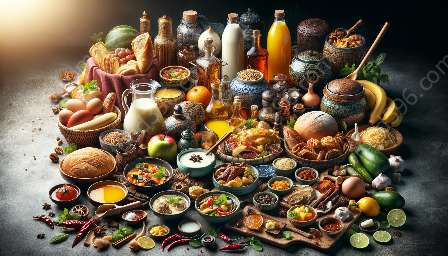Asia is a continent of diverse cultures, languages, and traditions, and one of the most prominent aspects that reflect this diversity is its food culture. The rich history and geographical expanse of Asia have given rise to a wide array of culinary traditions, each with its own unique flavors, ingredients, and cooking techniques. From the vibrant street food stalls of Southeast Asia to the elaborate feasts of East Asia, Asian food culture is a tapestry of flavors and stories that reflect the region's history, traditions, and values.
Regional Variations in Food Culture
One of the most compelling aspects of Asian food culture is the regional variations that exist within the continent. Each region boasts its own distinct culinary identity, shaped by factors such as geography, climate, historical influences, and local ingredients. These regional variations have given rise to a diverse tapestry of flavors and cooking styles that showcase the unique heritage and traditions of each area.
Southeast Asia:
Southeast Asia is renowned for its vibrant and aromatic cuisine, which is characterized by a harmonious blend of sweet, sour, salty, and spicy flavors. The region's food culture is heavily influenced by its tropical climate, abundant herbs and spices, and the historical trade routes that connected Southeast Asia with the rest of the world.
- Thailand: Thai cuisine is known for its bold flavors and aromatic herbs, with dishes like Tom Yum soup and Pad Thai gaining international acclaim.
- Vietnam: Vietnamese cuisine emphasizes fresh herbs and vegetables, with iconic dishes like pho and spring rolls showcasing the country's culinary finesse.
- Malaysia: Malaysian cuisine reflects the diverse cultural influences of the country, with dishes like Nasi Lemak and Laksa representing the rich tapestry of flavors.
East Asia:
East Asian food culture is deeply rooted in tradition, with a focus on balance, harmony, and aesthetic presentation. The region's diverse landscapes and climate have given rise to a wide variety of culinary traditions, each with its own unique cooking techniques and flavors.
- China: Chinese cuisine is renowned for its diversity, with regional variations such as Sichuan, Cantonese, and Hunan cuisine offering a wide range of flavors and cooking styles.
- Japan: Japanese cuisine emphasizes the beauty of simplicity and seasonal ingredients, with dishes like sushi, sashimi, and ramen gaining global popularity.
- Korea: Korean cuisine is characterized by its use of fermented ingredients and bold, spicy flavors, with dishes like kimchi and bibimbap representing the country's culinary heritage.
South Asia:
South Asian food culture is a reflection of the region's rich culinary heritage, with a focus on aromatic spices, bold flavors, and intricate cooking techniques. The diversity of South Asian cuisine is influenced by factors such as religion, history, and regional differences, resulting in a wide array of culinary traditions.
- India: Indian cuisine is celebrated for its use of aromatic spices and diverse regional dishes, with specialties like curry, biryani, and tandoori showcasing the country's culinary complexity.
- Pakistan: Pakistani cuisine is known for its rich and flavorful dishes, with a focus on meat-based curries and traditional bread like naan and roti.
- Bangladesh: Bangladeshi cuisine reflects the country's fertile land and abundant seafood, with dishes like hilsa curry and biryani symbolizing the depth of flavors in the region.
Food Culture and History
The food culture of Asia is deeply intertwined with its history, traditions, and values, and it serves as a reflection of the region's social, cultural, and economic dynamics. The history of Asian food culture is a narrative of trade, migration, conquest, and cultural exchange, with each event leaving an indelible mark on the culinary landscape of the continent.
Asian food culture is also deeply rooted in tradition and ritual, with food playing a central role in religious ceremonies, festivals, and social gatherings. The preparation and consumption of food are often imbued with symbolism, etiquette, and significance, reflecting the values and beliefs of the local community.
Moreover, the historical influences on Asian food culture have resulted in the fusion of different culinary traditions, leading to the creation of unique dishes and cooking styles. The trade routes that connected Asia with Europe and the Middle East facilitated the exchange of ingredients and cooking techniques, giving rise to iconic dishes like biryani, curry, and noodles that have become integral parts of Asian culinary identity.
Ultimately, the food culture of Asia is a dynamic tapestry of flavors, traditions, and histories that continues to evolve and captivate the world. Its regional variations and rich culinary heritage are a testament to the diverse and complex nature of the continent, drawing inspiration from its past while embracing the innovations of the present.

